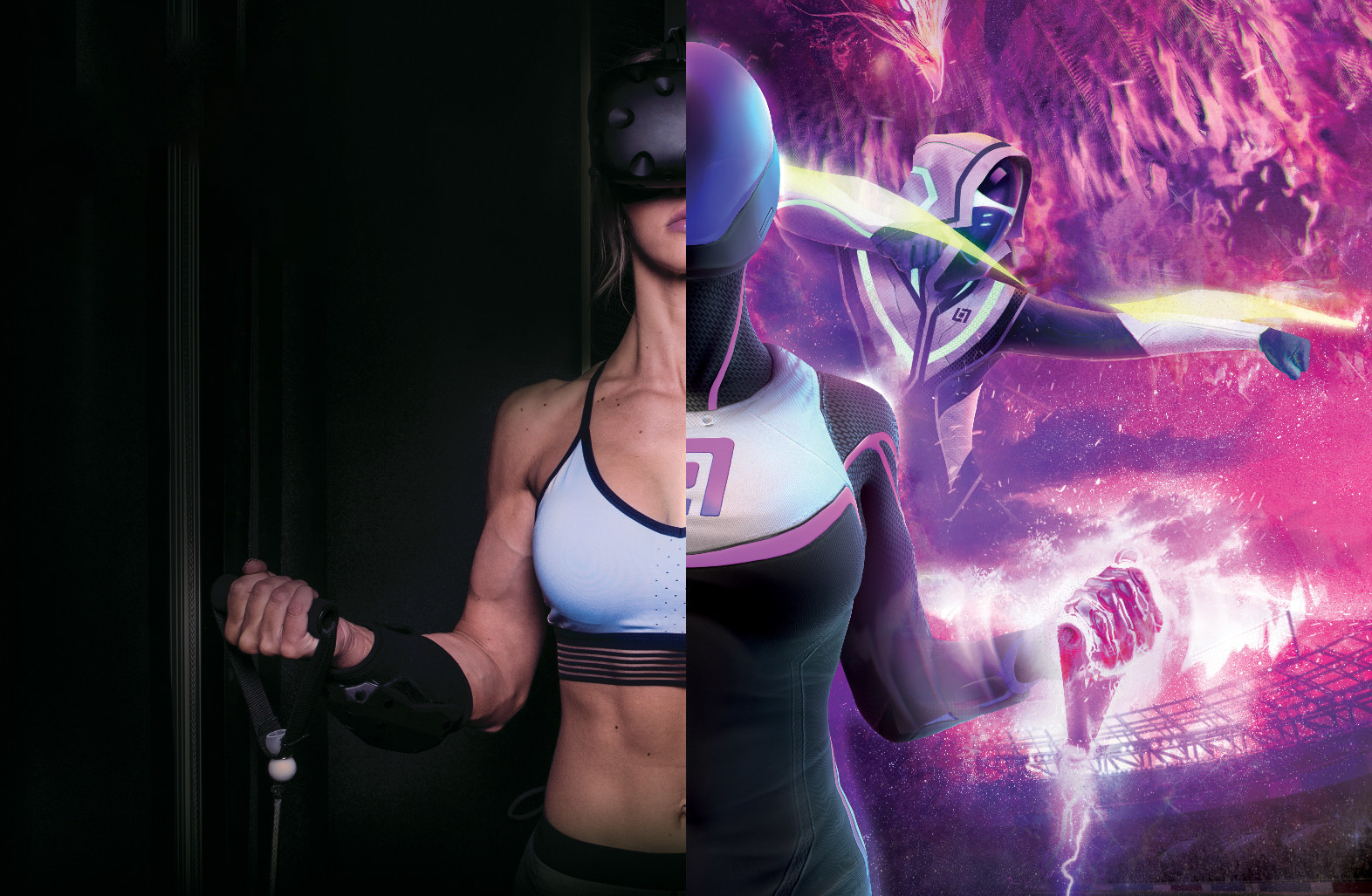If you’re just getting back to the gym after 18 months of exile due to COVID, you may want to look into some innovative exercise programs. That was me when I saw an ad for Black Box VR on Reddit. Taking them up on their free trial, I worked out in a virtual reality gym for the first time. It’s 30 minutes of high-intensity interval training that is a lot of fun.
Is it the next greatest thing in working out? To answer that question, I need to tell you a little about exergaming, exercise physiology, and virtual reality or VR.
Tough Sell for a VR Skeptic
I am not a VR fanboy. The thought of being blinded by a head-mounted display only to struggle with inaccurate controls and crash into a wall doesn’t get me excited. My experience with these kinds of things is getting cybersick from the tearing video and wildly swinging viewpoint. Color me a skeptic. However, I could not have been more wrong about the quality of the immersive VR at Black Box VR. The animation was smooth and comfortable. Despite how strenuously the workout taxed my body, I felt much less sick at the end than I would have from a session of Bikram yoga.
Exergaming History
Let’s take two steps back and talk about exergaming. A portmanteau of “exercise” and “gaming,” exergaming has evolved to its latest incarnation in immersive VR over the last two decades. Black Box VR can trace its roots to the innovations that happened with the advent of the Wii home video game console. The novelty of Wii, which helped it sell 100 million units, was the motion-sensing remote that allowed the console to track the user’s arm and hand movement in space. With the remote in hand, users could control sports games by making the same motion they would in real life. Boxing, tennis, bowling, baseball could all be played with realistic arm motions.
From gestures to full body motions
Nintendo added the Fit, a pressure sensing scale, as a peripheral which extended the user control for full-body exercises which relied on balance. The success of the Wii led Sony and Microsoft to develop their own competing products—the PlayStation Move and Kinect. The Sony product was mostly a “Wii too.” but the Kinect was something altogether different. Kinect’s depth-sensing camera tracked the user’s body in real-time, without any remote. Its computer vision could track your hand and skeleton in real-time and allow users to control games with their entire body, not just hand gestures. Kinect allowed developers to develop games that engaged the whole body like dancing, Zumba, and aerobics. I love the Xbox 360 with Kinect.
Exergaming Is Fun
Even though it is 15 years old, I play Dance Central several times a week when I don’t have time to run. During the time of COVID quarantines, it’s allowed me to mix up my workout schedule with runs and bodyweight to maintain my fitness. It’s a fun and fantastic technology, but it’s not that great a workout. At most, I get a moderate-intensity exercise session that barely challenges me.
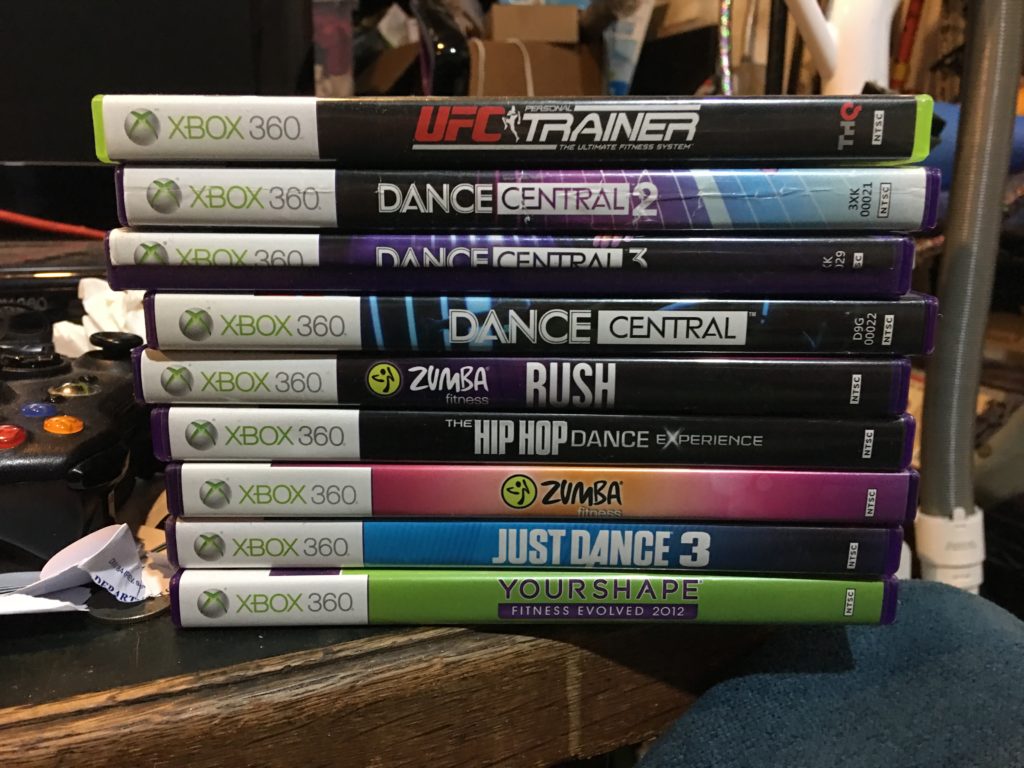
METs – Metabolic Equivalents
The science agrees with me. The Physical Activity Guidelines for Americans say that everyone should get 150–300 minutes of moderate-intensity activity (3.0-5.9 METs) or 75–150 minutes of vigorous-intensity activity (6.0 and higher METs) per week for optimal health benefits. Or some combination of both. If you went all out and danced flamboyantly in Dance Central, you might brush against 6 METs, but it’s unlikely. To meet the guidelines exergaming on Wii or XBox, you’d have to spend 5 hours a week at it.
What is a MET?
A MET, or metabolic equivalents, is a measure of energy expenditure. One MET is the energy you use when sitting still or resting for one minute. Using METs, researchers can compare the intensity of different exercises using the same unit of measure. If an activity is using 6 METs that means you’re exerting six times the energy than you would if you were sitting still. METs are a measure of your personal energy expenditure. If you weigh more, 1 MET might translate to more calories burned per minute for you than for someone who weighs less. This equation describes the relationship between calories and METs: Calories burned per minute = (MET x bodyweight in Kg x 3.5) ÷ 200.
Black Box VR Fitness – Immersive Gym and Gamified Fitness
On my scheduled day, I biked 20 minutes down to Market Street in San Francisco at the appointed time and was greeted by K, a resident Hero Trainer at the front desk. The lobby is spotless and shiny with neon and looks like a casino spa or an Avengers set. K gave me a quick tour. Down corridors branching off from the lobby, there are common rooms with lockers, showers, and a pre-workout bar. K led me to one of the 14 private rooms in the facility where I would be doing my session. The white-walled rooms are well-lit and spare, with a wide stripe of acoustic foam about chest height around the walls. I found this comforting, knowing that wasn’t anything else in the room to run into when I had on the head-mounted display (HMD). A black tower holds the rails for the two cable handles and moveable back/chest rest on one wall. First on go the forearms levees which have a slot for the plastic locator pucks. Next, K loosened up the HTC Vive headset. I had questions about my glasses, bifocals no less, and the answer was to keep them on. They fit under the eyepiece. (I took my glasses off to see what would happen. It’s blurry.) I got the HMD on, and… K promptly disappeared. The HMD showed me a replica of the room that I was in, minus my Hero Trainer. I realized that I wasn’t in Kansas anymore.
Black Box VR Gameplay
“Can you see your hands?” asked Kay. “Yep,” I said. “Okay, you’re good to go.” and with that, K presumably left the room. A button floated in front of me labeled “Activate session.” So I extended my hands and pushed it. Next, I just had to look at a target on the wall for the system to configure to my height. I was then led through an orientation on the gameplay and apparatus by a virtual assistant like Cortana. The AI doesn’t have a name that I could discern. She oriented me on the first three available exercises: The Chest Press, the Squat, and the Row. You select activities by picking an orb from a bank on your left and placing it in a hopper floating in front of the back/chest rest behind you. On the right hand is a bank of orbs to select allies to help you in the arena. You put their respective orb in a hopper in front of you. Each ally has an activation sequence of punches and slashes that you must do to put them on the field in the arena. By alternating exercise selections and ally recruitment, you keep yourself busy while the cables and back/chest pad move into position for the next exercise. It may sound complicated, but you get the hang of it almost immediately.
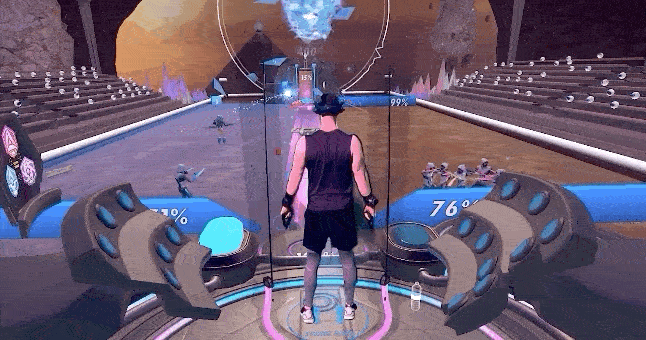
Intense 30-minute Workout
Select an exercise, and you are off. I started with the Row. The cables adjusted to about nipple height, so the kinematics were good. I turned around, pressed my chest into the pad that had moved into position, and grabbed the handles. Resistance started out trivially light but quickly ramped up to a significant load throughout the 20 reps in the first set. Each rep caused lightning to shoot out of my podium in the arena and attack the opponent’s crystal. I then selected the Chest Press. I waited while the cables and chest/back pad adjusted position. This activity was also pretty easy. I banged out 20+ more reps, and the attacks on the opponent did enough damage to destroy their crystal.
Intervals with active recovery
Winning the round gave me a minute or two rest while the arena reset for the next battle. I decided to try putting in some allies, popping Sheera’s orb into the hopper, and performing the slashes and punches to put her on the field. I brought in a few more allies, a couple of Sheeras, an Aquafirst, and a Windja. The active recovery of slashes and punches to activate the allies let me catch my breath for a few minutes before moving on to the next exercise. Back to the Row, which had gotten significantly more challenging than the previous set.
Supercharged, Hysterical!
When I hit ten reps, a booming “Supercharged” echoed in the arena, and my attacks seemed to do double damage. At 15 reps, I heard ‘Hysterical,” and damage doubled again. When I hit 20 reps, a window floated in front of me, telling me that I had maxed out the reps. I looked up at the scoreboard and was surprised to see that the timer had counted down 15 minutes. I was halfway through the workout and having fun. Each set seemed to get progressively more demanding (or my fatigue was catching up with me), so I averaged only 12 reps per set during the rest of the workout. At the end of the workout, I felt pretty good. My muscles were pumped, my heart rate was up. I felt like I had exercised. The first session is an orientation, so they start you out light and limit the variety of exercises, but I got a great workout in 30 minutes.
Outstanding Feature – Variable Cable Resistance
The variable resistance of the cables within sets has a dramatic impact on your workout. Most progressive resistance training wants you to work to muscle failure when you can’t do one more rep. The Black Box system increases the resistance on the cables until you max out at 12-15 reps. Then, if you can do more reps, it increases resistance. If you can do less, it decreases resistance. So you are always working towards failure. And when you are pushing a set to where you can’t get one more rep, you could be expending up to 56% more energy than if you didn’t go to failure. You’re optimizing your workout for maximum exertion. More practically, this automatic scaling of resistance means that you always have the correct weight in hand. This variable resistance is a massive improvement over working out with dumbbells at the gym. Not only are the dumbbells you want often in use by somebody else, The 5 lb intervals between dumbbells rarely exactly match my capabilities. I’m either blowing through an easy 20 reps with too light a weight or fading out at less than ten reps with a weight that’s too heavy.
Things I Liked
- Quality of the VR – The HTC Vive HMD is fully realized. Smooth, high framerate animation with no tearing or lag. I’m not an expert on VR, so I don’t know if this is state-of-the-art right now, but the display was first-rate. The tracking of head and hand positions was also crisp, smooth, and lag-free.
- Quality of exercise – The servos that control the cable resistance were smooth and ramped up on a pretty smooth curve. The tensioning at the beginning and the release at the end of the set were intuitive and non-jarring.
- Spacious room- Being in the spare, uncluttered room with high ceilings, I never felt like I was going to smack into a wall.
- Gameplay – Gameplay is fast and kinetic. It feels like a race, but not rushed. I had time to focus on the correct form for the exercises and intervals for active recovery.
- Great venue – The facility and rooms are clean, quiet, spacious, and well lit. It’s a comfortable place to be with the familiar amenities of a gym.
Things I Liked Less
- Pucks and cables – My Hero Trainer K had me position the forearms sleeves to the tracking pucks stay flat across my forearms. In this position, the cables would press against them at full extension on some of the exercises. I rotated them to the side, and they seemed to clear a little better.
- Limited exercises – During my second session, there were more choices, including Overhead Press and Stiff-legged Squat, but I can imagine this will get boring quickly.
- Anxious about form – There’s a reason gyms and dance studios have mirrors on the walls. It’s so you can see the position of your body. With only the first-person view of VR, you don’t have those points of reference. I had to focus intently on how the exercise felt to get my body in the ideal position. Relying on feel to get into the proper position may be a benefit for exercisers.
- Distracted from gameplay – During my second and third sessions, the exercises were so taxing that I couldn’t focus on anything in the arena. I learned from the website that there are many strategies one can employ to select exercises and allies that optimize their effectiveness against various opponents. Unfortunately, I didn’t get the opportunity to learn much of that while focusing on making good reps.
Is It Good Exercise?
The program of Black Box is educated by the consensus principles of effective high-intensity interval training. Progressive overload and multiple sets to failure are the modalities of the workout. On their website, Black Box cites lots of studies that they considered in their design. In addition, there are testimonials and pictures of ripped social media fitness influencers on their website that give that impression. I know that I had a good workout, but I want to see third-party validation. Last month, a team including Brett Dolezal at UCLA Medical School published a study of physical demands and perceived effort of Black Box VR. The study suggests that the answer is a resounding YES! Two of the findings of the study were particularly surprising.
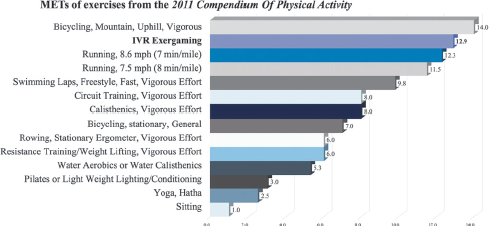
The study found that Black Box VR is a very demanding workout. Remember when we looked at the METs of the previous generation of exergaming? Xbox Kinect and Wii could barely break 6 METs, with most games registering 4 METs or less. However, the Immersive VR game at Black Box racked up an astounding 12.9 METs. That’s more than circuit training or running 7 minutes miles.
Even more surprising is that despite the energy that subjects were expending in their workout, their perceived exertion was considerably less. On average, subjects rated the exercise as “Somewhat Hard to Hard.” On the other hand, their heart rate (which previous research has shown to be highly correlated to energy expenditure) suggested the workout was “Very Hard.” The authors propose a possible reason for this discrepancy: the gameplay dynamics distract the exerciser from the fatigue they are experiencing. That sounds about right to me. The hope is lower perceived exertion will make it easier for people to stick with an immersive VR exercise program and get the recommended physical activity for optimal health.
Measure to Manage
In addition to the gameplay and workout, BlackBox has an app with many social elements like you would see in any eSport league. You can earn experience points, badges, levels, notifications, and see event feeds from all the athletes using Black Box at any of their 6 locations in the US. Whether or not you are motivated by the gamification elements, all that data is a goldmine for tracking your progress. You can see a startling amount of detail about each of your battles. The exercises, sets, and reps you accomplished and the amount of weight you lifted are all noted. This kind of progress tracking is incredibly motivating and saves me from taking notes on my exercise sessions. As I dug deeper into the app, I found people who had similar fitness levels to my own and benchmarked my progress against theirs.
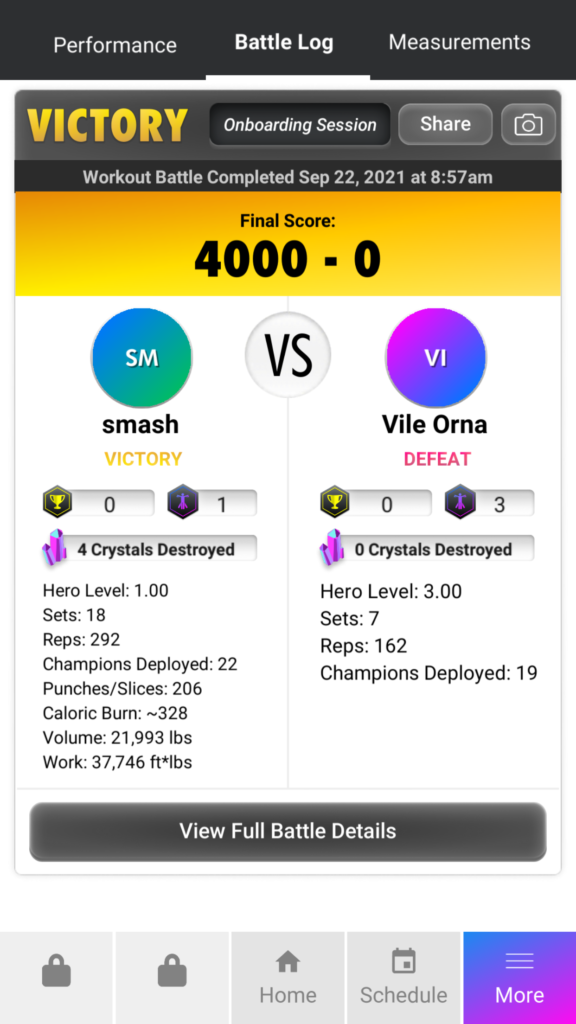
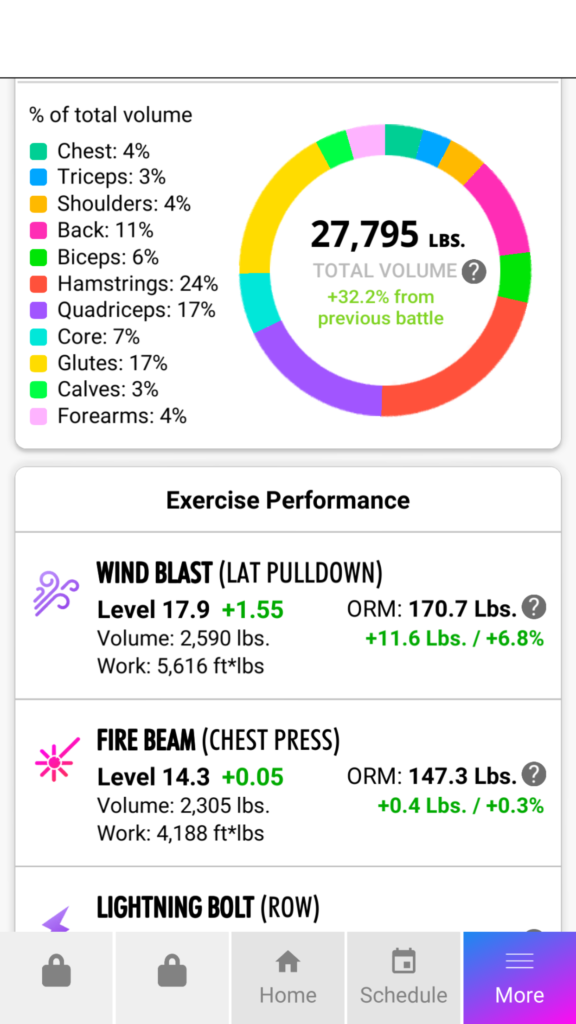
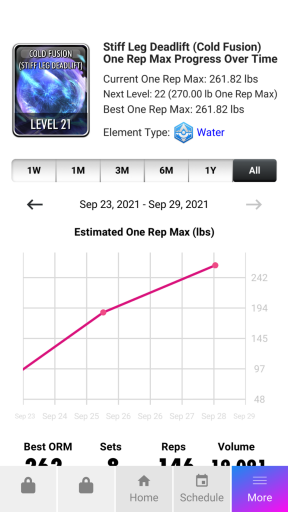
Too Good To Pass Up
I’ve gone from a skeptic into a believer. Black Box launched just before the COVID pandemic, so it lost momentum when all gyms closed for the last 18 months. Now that things are opening up, it is an opportune time to check them out. Black Box is making it easy with a free two-week trial. You can get in 6 sessions and experience the game progression as you get stronger. In subsequent sessions, new exercises and challenges open up as you work through the game. You’ll get a tremendously challenging workout that will tax you more than boxing or running at a 7-minute mile pace, all in only 30 minutes. And it feels like a lot less work than it is. The overall fun experience, gamification elements, and distraction from fatigue may make it easier for you to stick with the program and get the amount of physical activity you need for optimum health. And you might get ripped.
